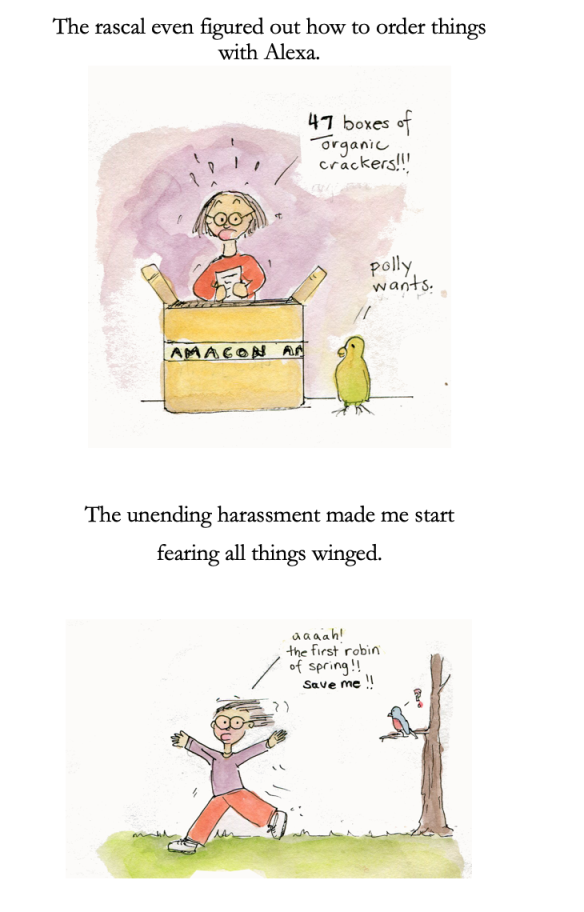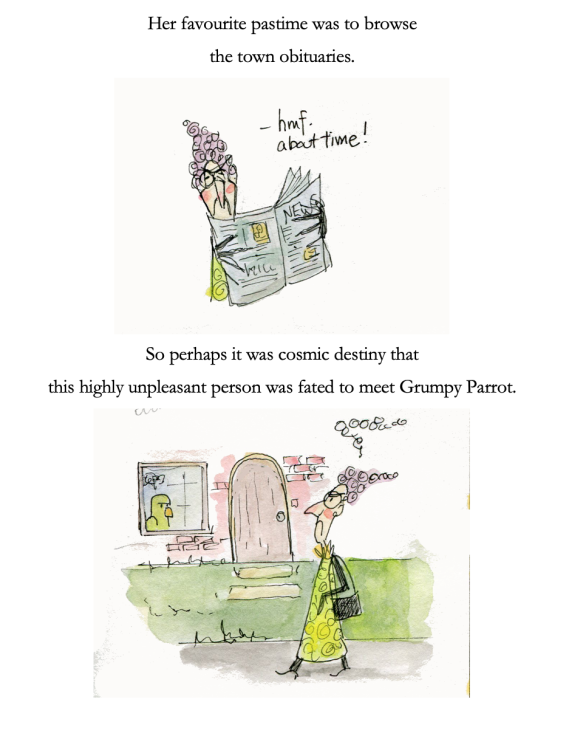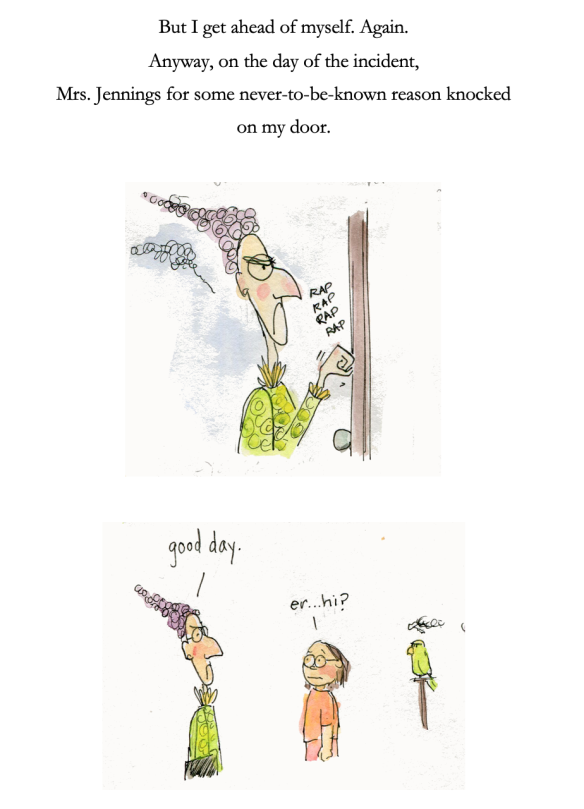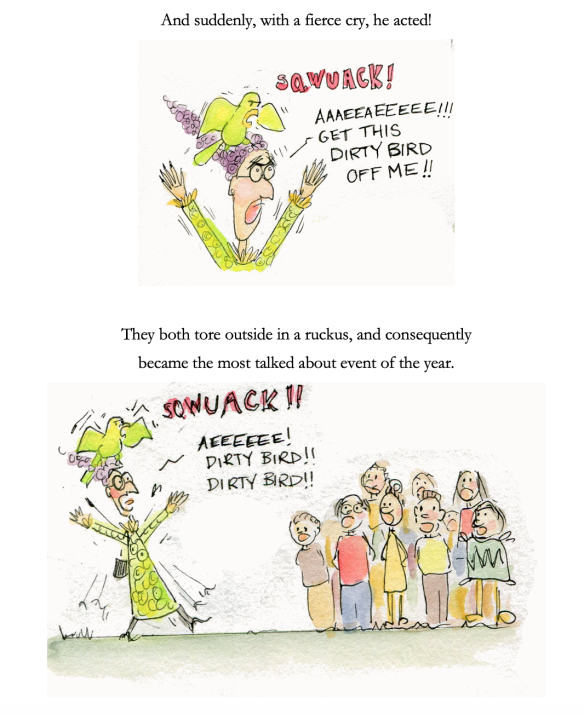




































































Yesterday I had the pleasure of attending a talk by Barbara Yelin, German illustrator and author. She was demo-ing a live drawing session as part of the Toronto Comic Art Festival. In addition to being an enchanting speaker, Yelin’s artwork is marvelous. I particularly liked some of the images she showed from one of her wordless earlier works: Le Visiteur.
 In Le Visiteur, Yelin explained how she uses drawing as a means to uncover her characters and eventually, the plot. For example, she described how she would draw an interesting space, and old house for example, and as she kept drawing perhaps a laneway would appear, lined with trees. And in a drawing after that, perhaps a small figure would appear.
In Le Visiteur, Yelin explained how she uses drawing as a means to uncover her characters and eventually, the plot. For example, she described how she would draw an interesting space, and old house for example, and as she kept drawing perhaps a laneway would appear, lined with trees. And in a drawing after that, perhaps a small figure would appear. As she moved (or drew rather) closer, she might discover this character is in fact a little girl carrying a basket of fish. And eventually perhaps another character – a giant of a bird – may turn up. Voila, protagonist and antagonist, respectively. And the story evolves and continues in this way, drawing after drawing revealing who and what happens next.
As she moved (or drew rather) closer, she might discover this character is in fact a little girl carrying a basket of fish. And eventually perhaps another character – a giant of a bird – may turn up. Voila, protagonist and antagonist, respectively. And the story evolves and continues in this way, drawing after drawing revealing who and what happens next.
 Contrast this with some of her later work, which arguably is more in keeping with the standard graphic novel tradition of page layouts, panels, dialogue and narrative, and related elements.
Contrast this with some of her later work, which arguably is more in keeping with the standard graphic novel tradition of page layouts, panels, dialogue and narrative, and related elements. While the latter is sophisticated – evincing thought, planning and effort, as well considerable technical skill (see page spreads in Irmina) one might wonder if there is something, some spark of deep, dusky intuition, that is best nurtured when coaxed from a drawing, as opposed to when words and plot must march to page layouts and drawings must live within panel borders.
While the latter is sophisticated – evincing thought, planning and effort, as well considerable technical skill (see page spreads in Irmina) one might wonder if there is something, some spark of deep, dusky intuition, that is best nurtured when coaxed from a drawing, as opposed to when words and plot must march to page layouts and drawings must live within panel borders.
Please visit Barbara Yelin’s blog to see more of her wonderful work: http://barbarayelin.de/aktuell/
I’ve been working on a story for some time now and have been trying out a few formats and styles. The first version was wordless, and seeing as that didn’t work out so well, I’m trying my hand at including words. Here are a few draft pages, hopefully they aren’t too difficult to make out… I have a fraught relationship with my scanner as will no doubt become evident. Some of you may recognize the character from previous illustrated posts on Camus quotes. 🙂
Over the last few months I’ve had the great pleasure of working with children via an artist in residence pilot program at Ryerson University. Curiously I think I learned more from them than they did from me…
The first experimental tranche involved working on large painting while encouraging them to do their own. That idea didn’t last too long once they decided they wanted to help me instead.  The interesting thing is that the large painting wasn’t quite coming together until they started helping and working with tools and ideas I hadn’t even considered. Check out these tiny little hands doing incredible stuff! Some of them were even jumping to reach the top of the canvas – we decided then that this was dynamic painting in its most literal iteration. 🙂
The interesting thing is that the large painting wasn’t quite coming together until they started helping and working with tools and ideas I hadn’t even considered. Check out these tiny little hands doing incredible stuff! Some of them were even jumping to reach the top of the canvas – we decided then that this was dynamic painting in its most literal iteration. 🙂
This was the final happy result, representing about 12 small hands, 24 wide eyes, and 12 open imaginations.
I’ll post a few things on the sculpture experiments another time, but wanted to end this post with the following lovely poem by Margaret Atwood.
You Begin
You begin this way:
this is your hand,
this is your eye,
this is a fish, blue and flat
on the paper, almost
the shape of an eye
This is your mouth, this is an O
or a moon, whichever
you like. This is yellow.
Outside the window
is the rain, green
because it is summer, and beyond that
the trees and then the world,
which is round and has only
the colors of these nine crayons.
This is the world, which is fuller
and more difficult to learn than I have said.
You are right to smudge it that way
with the red and then
the orange: the world burns.
Once you have learned these words
you will learn that there are more
words than you can ever learn.
The word hand floats above your hand
like a small cloud over a lake.
The word hand anchors
your hand to this table
your hand is a warm stone
I hold between two words.
This is your hand, these are my hands, this is the world,
which is round but not flat and has more colors
than we can see.
It begins, it has an end,
this is what you will
come back to, this is your hand.
— Margaret Atwood
I recently came across an interesting book, The Hokasai Manga. Given Hokusai was born in 1760, he was certainly ahead of his time when it comes to a current definition of manga, although at that time it simply meant “sketches”. Sketches they certainly are, all 3,900 of them.
Here is a sketch of a carp I adapted from one of his works in the book (Gyoran Kannon).
 I’ve always loved his masterpiece The Great Wave off Kanagawa, and in particular his views on mastery, as espoused by the following words:
I’ve always loved his masterpiece The Great Wave off Kanagawa, and in particular his views on mastery, as espoused by the following words:
“At the age of five years I had the habit of sketching things. At the age of fifty I had produced a large number of pictures, but for all that, none of them had any merit until the age of seventy. At seventy-three finally I learned something about the true nature of things, birds, animals, insects, fish, the grasses and the trees. So at the age of eighty years I will have made some progress, at ninety I will have penetrated the deepest significance of things, at a hundred I will make real wonders and at a hundred and ten, every point, every line, will have a life of its own..”
Beautiful eh? Talk about taking the long view.. makes a refreshing change to the 10,000 hour maketh an expert concept, which translates to about five full-time years. That would make one but an infant in Hokusai’s book!
P.S. For more musing on these subjects, see an earlier two-part post – Flow, Meaning & A State of Grace.
Russell Edson’s poem, The Floor, has been rattling around in my head for a few days – in particular, its brilliant last line describing the brain as “this teetering bulb of dread and dream..” To me, Edson’s words perfectly capture the continuous mental oscillation between fear and Pandora’s box of eternal hope.
Somehow, this got conflated with an art assignment meant to depict the ambiguous, the ephemeral, and the visceral and I came up with this arguably creepy sketch (I should really have used CFL bulbs, but wouldn’t have had quite the same effect 🙂
 When drawing, I was also thinking about the tall and god-like figures in Scorched Earth by Lawrence Paul Yuxweluptun and Dali’s The Temptation of St. Anthony. Russell Edson’s poem is reproduced below, and some mind-expanding reading on this area can be seen here.
When drawing, I was also thinking about the tall and god-like figures in Scorched Earth by Lawrence Paul Yuxweluptun and Dali’s The Temptation of St. Anthony. Russell Edson’s poem is reproduced below, and some mind-expanding reading on this area can be seen here.
The Floor
The floor is something we must fight against.
Whilst seemingly mere platform for the human
stance, it is that place that men fall to.
I am not dizzy. I stand as a tower, a lighthouse;
the pale ray of my sentiency flowing from my face.
But should I go dizzy I crash down into the floor;
my face into the floor, my attention bleeding into
the cracks of the floor.
Dear horizontal place, I do not wish to be a rug.
Do not pull at the difficult head, this teetering
bulb of dread and dream . .
— Russell Edson